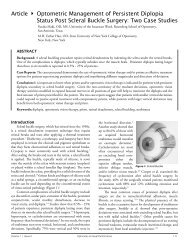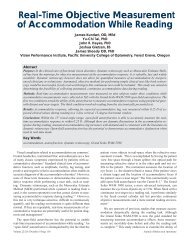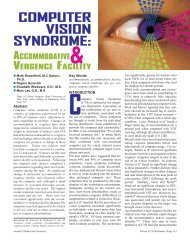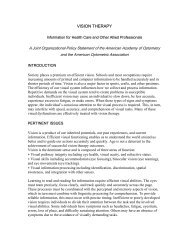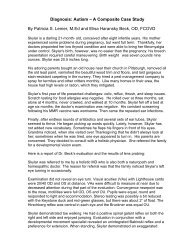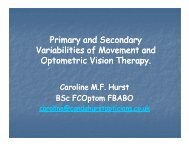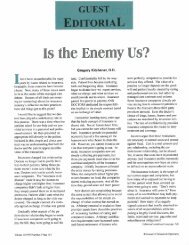UNILATERAL SPATIAL INATTENTION (NEGLECT)
UNILATERAL SPATIAL INATTENTION (NEGLECT)
UNILATERAL SPATIAL INATTENTION (NEGLECT)
You also want an ePaper? Increase the reach of your titles
YUMPU automatically turns print PDFs into web optimized ePapers that Google loves.
<strong>UNILATERAL</strong>-<strong>SPATIAL</strong> <strong>INATTENTION</strong>\ICBO CONGRESSPOMONA. CAAPRIL 8, 2010ROBERT B. SANET, O.D., F.C.O.V.D.San Diego Center for Vision Care7898 BroadwayLemon Grove CA 91945rsanet@cs.com
<strong>UNILATERAL</strong> <strong>SPATIAL</strong> <strong>INATTENTION</strong> (<strong>NEGLECT</strong>)GENERAL CHARACTERISTICS
<strong>UNILATERAL</strong> <strong>SPATIAL</strong> <strong>INATTENTION</strong> (<strong>NEGLECT</strong>)• Many Names: Unilateral l Spatial Neglect, Hemi-Neglect,Unilateral Spatial Inattention• Involuntary failure, or reduced ability to attend or respondto meaningful sensory stimuli presented in the affectedhemi-field• As opposed to a hemianopsia, it is not caused by a defectin the Geniculo-Striate pathway• May or may not be accompanied by hemiplegia andhomonymous hemianopsia
<strong>UNILATERAL</strong> <strong>SPATIAL</strong> <strong>INATTENTION</strong> (<strong>NEGLECT</strong>)• Usually the result of a right parietal lobe lesion, but it canoccur as a result of damage in many other areas of thecortex• Stroke is the most common cause• Mechanism is not totally t clear• May affect Personal Space (body image), Peri-PersonalSpace (within arms reach) or Extra Personal Space(outside of arms reach)• Neglect may be complete or relative stimulus/intensity• Neglect may be complete or relative-stimulus/intensitydependant
<strong>UNILATERAL</strong> <strong>SPATIAL</strong> <strong>INATTENTION</strong> (<strong>NEGLECT</strong>)• Competitive process• Sometimes may only occur with simultaneous presentation(extinction phenomenon)• May present with any combination of visual, auditory or tactilestimuli• More devastating, but also more remediable than a visual fielddefect• The presence of neglect more than 3 months post stroke is amajor predictor of Activities for Daily Living (ADL) abilities
<strong>UNILATERAL</strong> <strong>SPATIAL</strong> <strong>INATTENTION</strong> (<strong>NEGLECT</strong>)PREDICTOR OF TREATEMENT OUTCOMES
VISUAL-<strong>SPATIAL</strong> <strong>SPATIAL</strong> <strong>INATTENTION</strong>ANDACTIVITIES FOR DAILY LIVING (ADL)• Study by Katz , Hartman-Maeir, et. al, 1999• Conducted at the School of Occupational Therapy, Hebrew Universityof Jerusalem, Israel• Objective was to evaluate the impact of unilateral spatial neglect(USN) on the rehabilitation outcome and long-term functioning inactivities of daily living (ADL) in right hemisphere damaged strokepatients• Assessed sensory motor and cognitive impairment and functional• Assessed sensory-motor and cognitive impairment and functionaldisability upon admission to rehabilitation, upon discharge fromrehabilitation hospital and 6 months after discharge
VISUAL-<strong>SPATIAL</strong> <strong>SPATIAL</strong> <strong>INATTENTION</strong>ANDACTIVITIES FOR DAILY LIVING (ADL)Results:• Neglect is associated with lower performance on measures ofimpairment (sensory-motor and cognitive), as well as on measuresof disability in ADL• Differences were significant in all testing periods admission,discharge, and 6 months post discharge• The recovery pattern for patients with USN is slower and moreattenuated• USN is the major predictor of rehabilitation o tcome from admission• USN is the major predictor of rehabilitation outcome from admissionto follow-up
<strong>UNILATERAL</strong> <strong>SPATIAL</strong> <strong>INATTENTION</strong> (<strong>NEGLECT</strong>)PROPOSED MECHANISMS
<strong>UNILATERAL</strong> <strong>SPATIAL</strong> <strong>INATTENTION</strong> (<strong>NEGLECT</strong>)Vallar & Perani, 1986• Considerable evidence that damage to the inferior parietallobule (IPL), more than any other brain region, produces theclassic symptoms of neglect• Region of the IPL appears to be at the apex of a multistagecortical processing stream• IPL receives inputs from subcortical structures that carryIPL receives inputs from subcortical structures that carryocularmotor and attentional signals
<strong>UNILATERAL</strong> <strong>SPATIAL</strong> <strong>INATTENTION</strong> (<strong>NEGLECT</strong>)Vallar & Perani, 1986• IPL integrates t somatic, visual, and movement information• IPL appears to be one of the primary cortical regionsgoverning attention• The IPL is thought to be part of the ventral stream
<strong>UNILATERAL</strong> <strong>SPATIAL</strong> <strong>INATTENTION</strong> (<strong>NEGLECT</strong>)Milner and Goodale, 1995:• Superior parietal lobe is part of dorsal stream which mediates controlof goal directed actions• Lesions restricted to the superior parietal lobe lead to disturbancesin visuomotor control (optic ataxia)• Lesions of the inferior parietal lobe lead to spatial neglect• Due to damage to areas which deals with abstract spatial reasoning,based on input from the ventral stream which permits the formation ofperceptual p and cognitive representations which embody the enduringcharacteristics of objects and their significance
<strong>UNILATERAL</strong> <strong>SPATIAL</strong> <strong>INATTENTION</strong> (<strong>NEGLECT</strong>)Perenin, 1997:• Superior part of the parietal cortex is involved with directcoding of space for action• Inferior part or parietal lobe is responsible for moreenduring and conscious representations underlying spatialcognition o and awarenessa ess
<strong>UNILATERAL</strong> <strong>SPATIAL</strong> <strong>INATTENTION</strong> (<strong>NEGLECT</strong>)Karnath, 1997:• The brain uses inputs from various afferent channels toelaborate a unitary representation of egocentric space• Neglect due to an altered representation of body-centeredspaceI l t th di t t f ti h t ti• In neglect the coordinate transformation has a systematicerror that results in deviation of the spatial reference to theipsilateral side
<strong>UNILATERAL</strong> <strong>SPATIAL</strong> <strong>INATTENTION</strong> (<strong>NEGLECT</strong>)Kinsbourne, 1987:• Orientation is not intact in in either right or left hemispace• A lateral gradient of attention sweeps across bothhemispheres• There a gradient of severity of the neglect across the entirevisual field
<strong>UNILATERAL</strong> <strong>SPATIAL</strong> <strong>INATTENTION</strong> (<strong>NEGLECT</strong>)Rizzolatti and Berti, 1990:• Neglect results from a lesion in higher order spatial maps• There is gradient of severity across the visual field with a• There is gradient of severity across the visual field with amaximum severity in the in the extreme contralateralhemifield to a minimum severity in the extreme ipsilateralfield
<strong>UNILATERAL</strong> <strong>SPATIAL</strong> <strong>INATTENTION</strong> (<strong>NEGLECT</strong>)Summary of Research:• Many varied presentations of USI depending on the specific brainarea(s) involved• Inferior parietal lobule (IPL), more than any other brain region,produces the classic symptoms of neglect. However, it must beremembered that many different cortical areas may produce neglect• May present as problems with various functions and areas of space- Body image- Visuo-motor control- Cognition- Attention• USI appears to manifest as a biased gradient of attention across theentire visual field
<strong>UNILATERAL</strong> <strong>SPATIAL</strong> <strong>INATTENTION</strong> (<strong>NEGLECT</strong>)EVALUATION
<strong>UNILATERAL</strong> <strong>SPATIAL</strong> <strong>INATTENTION</strong> (<strong>NEGLECT</strong>)Visual Field Defect-No Neglect-???
<strong>UNILATERAL</strong> <strong>SPATIAL</strong> <strong>INATTENTION</strong> (<strong>NEGLECT</strong>)Visual Field Defect-??? Neglect??? Both???
OPTOMETRIC EVALUATIONOFTHE ABI PATIENT WITH VISUAL <strong>SPATIAL</strong> <strong>NEGLECT</strong>PROBES:• Questions to patient/caregiver regarding behavior• Patient’s awareness of problem• Observe Behavior• Drawing tests: Clock, Flowers, etc.• Scanning Tests• Line Bisection Cross Out Task (Suter analysis)• Two Penlights-Extinction• Read Hart Chart• Auditory/tactile stimuli
FIGURE DRAWING TESTS
DRAW A CLOCK
FLOWER COPYING TEST
LINE BISECTION TEST
CANCELLATION TESTS
NAVON FIGURESGlobal vs. Local Features
Caution!LINE BISECTION TEST• Study by Ferber & Karnath, 2001• Examined validity of a line bisection test and four cancellation tests• Found that the line bisection test missed 40% of the neglect patients• Cancellation tests only missed 6% of the subjects• Deviations in line bisection may be indicative of other conditions,such as hemianopia• Conclusions: Result calls into question line bisection tests as a validassessments tool and confirmed the use of cancellation tests
Line Bisection Cross Out TaskThe Line Bisection Cross Out Task (by Suter)• In deep neglect, the patient will neglect to bisect the lines on oneside of the paper• In lesser neglect, the patient will bisect all of the lines, but the linesgreater than 5 cm in length will be bisected away from the neglectedfield• A patient with a hemianopsia without neglect tends to bisect the linep p gtoward the blind field, as if they are aware of the defect andovercompensate in the process
Line Bisection Cross Out TaskThe Line Bisection Cross Out Task (by Suter)• There is a caveat to the right-left bisection bias… a patient with ahemianopsia plus neglect may bisect the lines accurately• Do not get out your ruler to score. Healthy normal subjects seem toshow a slight bias to left side, so if you score with a ruler, everyonewill be a neglect suspect• If truly present, the differences should be easily discerned by“eyeballing” the sheet
GRADIENT OF <strong>NEGLECT</strong>
<strong>UNILATERAL</strong> <strong>SPATIAL</strong> <strong>INATTENTION</strong> (<strong>NEGLECT</strong>)TREATMENT
TREATMENT OPTIONSFOR<strong>UNILATERAL</strong> <strong>SPATIAL</strong> <strong>INATTENTION</strong>• Vestibular Stimulationi• Hemi-Spatial Sun Rx• Yoked Prisms• Optokinetic Stimulation
TREATMENT OPTIONSFORVISUAL-<strong>SPATIAL</strong> <strong>INATTENTION</strong>VESTIBULAR TREATMENT
TREATMENT OPTIONSFORVISUAL-<strong>SPATIAL</strong> <strong>INATTENTION</strong>VESTIBULAR TREATMENT• Neglect temporarily improved by caloric stimulation,Neglect temporarily improved by caloric stimulation,neck vibration and optokinetic stimulation, but effectsare transitory-lasting no more than 10-12 minutes
TREATMENT OPTIONSFORVISUAL-<strong>SPATIAL</strong> <strong>INATTENTION</strong>HEMI-<strong>SPATIAL</strong> SUNGLASSES
TREATMENT OPTIONSFORVISUAL-<strong>SPATIAL</strong> <strong>INATTENTION</strong>HEMI-<strong>SPATIAL</strong> SUNGLASSESStudy by Arai, Ohi, et. al 1997• 10 patients with unilateral left neglect• Used copying and line bisection tasks
TREATMENT OPTIONSFORVISUAL-<strong>SPATIAL</strong> <strong>INATTENTION</strong>HEMI-<strong>SPATIAL</strong> SUNGLASSESStudy by Arai, Ohi, et. al 1997• Used Hemi-Spatial Sun Rx• Using spectrometer:90% light penetration in the unshaded half08% light penetration in the shaded half
TREATMENT OPTIONSFORVISUAL-<strong>SPATIAL</strong> <strong>INATTENTION</strong>HEMI-<strong>SPATIAL</strong> SUNGLASSESStudy by Arai, Ohi, et. al 1997• 4 out of 10 patients showed some improvement• One patient demonstrated dramatic and lastingimprovement in functional activitiesiti
TREATMENT OPTIONSFORVISUAL-<strong>SPATIAL</strong> <strong>INATTENTION</strong>YOKED PRISM(PRISM ADAPTATION)
TREATMENT OPTIONSFORVISUAL-<strong>SPATIAL</strong><strong>SPATIAL</strong> <strong>INATTENTION</strong>YOKED PRISM (PRISM ADAPTATION) TREATMENTStudy by Rossetti, et. al 1998• 12 patients with right brain damage, mean age 62 years• All in neuro rehabilitation hospital for moderate to severehemiplegia i and somatosensory dysfunction secondary to stroke
TREATMENT OPTIONSFORVISUAL-<strong>SPATIAL</strong><strong>SPATIAL</strong> <strong>INATTENTION</strong>YOKED PRISM (PRISM ADAPTATION) TREATMENTStudy by Rossetti, et. al 1998• Study took place 3 weeks->14 months post stroke (average 9 weeks)• Used 10 degree (18 prism diopter) Base Left prisms• Performed simple pointing task
YOKED PRISM (PRISM ADAPTATION) FOR VISUAL-<strong>SPATIAL</strong> <strong>INATTENTION</strong>
YOKED PRISM (PRISM ADAPTATION) FOR VISUAL-<strong>SPATIAL</strong> <strong>INATTENTION</strong>
YOKED PRISM (PRISM ADAPTATION) FOR VISUAL-<strong>SPATIAL</strong> <strong>INATTENTION</strong>Study by Rossetti, et. al 1998…continued• In the study, using Yoked Prisms, the positive effect was a minimumof two hours, as compared to other treatments where the effectslasted no more than 10-12 minutes• Positive effect were found for both sensorimotor and cognitivespatial functions• “The prisms do not merely act as a passive modifier of sensoryafferents (like caloric, vibrational, or optokinetic stimulation), butcan be seen as stimulating active processes involved in theplasticity of sensorimotor correspondences by activating brainfunctions related to multisensory integration and spacerepresentation.”
YOKED PRISM (PRISM ADAPTATION) FOR VISUAL-<strong>SPATIAL</strong> <strong>INATTENTION</strong>Study by Rossetti, et. al 1998…continuedPostulated mechanisms to account for the strong improvement inpatients with neglect:• Stimulation of short-term plasticity of brain functions related to spatialtransformations and spatial representation may favor the neuralrestoration of the right hemispheric functions when they have beenimpaired by a lesion• Exposure alters the coordinate transformations used by the nervoussystem to represent extrapersonal space
YOKED PRISM (PRISM ADAPTATION) FOR VISUAL-<strong>SPATIAL</strong> <strong>INATTENTION</strong>Study by Rossetti, et. al 1998…continuedSome conclusions by the authors of the study:• “The dramatic improvement induced by prism adaptation suggeststhat a signal is given to the brain that stimulates the recovery process”• “An attractive aspect of the prism exposure lies in it’s non-invasivenature, acceptability to patients, and ease of use”• “The duration of the effects, owing to central active process beingactivated, indicates that this technique may come top have a major rolein the neuropsychological l rehabilitation i of hemispatial i neglect.”
YOKED PRISM (PRISM ADAPTATION) FOR VISUAL-<strong>SPATIAL</strong> <strong>INATTENTION</strong>Study by Rossetti, et. al 1998…continued• Rossetti’s s work had been replicated by many researchers,in most cases with with similar results:‣ Mcintosh, et. al., 2002‣ Farne, et. al., 2002‣ Frassinetti, et. al., 2002‣ Rode, et. al., 2003‣ Luate, et. al., 2006‣ Sumitani, et. al., 2007‣ Seriano, et. al., 2007
<strong>UNILATERAL</strong> <strong>SPATIAL</strong> <strong>INATTENTION</strong>EXCELLENT REFERENCE ON PRISM ADAPTATION !!!• Published in Journal of Behavioral a Optometry, 2009• Author: Maura E. Massucci, OD• Title: Prism Adaptation in the Rehabilitation ofPatients with Unilateral Spatial InattentionMassucci, ME. Prism adaptation in the rehabilitationof patients with unilateral spatial inattention. J BehavOptom 2009; 20:101-105105
TREATMENT OPTIONSFORVISUAL-<strong>SPATIAL</strong> <strong>INATTENTION</strong>OPTOKINETIC STIMULATION
OPTOKINETIC O STIMULATIONStudy by Kerkhoff, Keller, et., al. 2006• Published in Restorative Neurology and Neuroscience• Evaluated pre and post treatment t t using line bisection tests t andcancellation tests in two matched groups• Transfer was assessed using paragraph reading tests
OPTOKINETIC O STIMULATIONStudy by Kerkhoff, Keller, et., al. 2006• Performed 5 treatment sessions of repetitive OKN stimulation• Used the PC based EYEMOVE program: Visual displays ofobjects all moving coherently toward the neglected side
OPTOKINETIC O STIMULATIONStudy by Kerkhoff, Keller 2006• Control group did conventional scanning training• Found positive in all of the tests t administered i d and transfer toparagraph reading• Effect from OKN occurred in both high and low velocitymovement and with large and small sized displays
OPTOKINETIC O STIMULATIONStudy by Kerkhoff, Keller 2006Kerkhoff and associates offered two compatible hypothesis foreffect of OKN on Neglect‣ OKN facilitates the directing of attention toward the neglectedregions of space. The improved attention allocation leads toimproved exploration of leftward space‣ Leftward OKN facilitates more accurate egocentric spacerepresentation by providing visual directional input therebyinfluencing spatial perception and attention
OPTOKINETIC O STIMULATIONAdditional studies on OKN and Neglect• Vallar, et., al 1997 found positive effects from OKN visualdisplays on arm position and other arm and hand functions• Sturm et., al. 2006, using the EYEMOVE program foundreactivation of cortical regions including angular gyrus,temporal-occipital p areas, pre-cuneus and the posterior cingulategyrus
<strong>UNILATERAL</strong> <strong>SPATIAL</strong> <strong>INATTENTION</strong> (<strong>NEGLECT</strong>)CONCLUSION
Conclusion:VISUAL-<strong>SPATIAL</strong> <strong>INATTENTION</strong>• Visual Spatial Inattention (Neglect) is a major source ofstroke-related long-term disability• Yoked prisms (prism adaptation), optokinetic stimulationand hemispatial sun Rx’s, appear to be useful tools toremediate unilateral spatial inattention• The profession of Optometry has the potential to play animportant role in applying these therapeutic modalitiesto remediate unilateral spatial inattention
THANK YOU
<strong>UNILATERAL</strong> <strong>SPATIAL</strong> <strong>INATTENTION</strong>
<strong>UNILATERAL</strong> <strong>SPATIAL</strong> <strong>INATTENTION</strong>REFERENCES:• Kinsbourne, : Mechanisms of unilateral neglect. In:Neurophysiological and neuropsychological aspects of spatialneglect (ed: M. Jennerod) Amsterdam, North Holland pp. 69-86, 1987• Rizzolatti and Berti, Neglect as a neural representational deficit. Rev.Neurol. 146, 626-634, 1990• Rossetti, et. al Prism adaptation to a rightward optical deviationrehabilitates left hemispatial neglect. Nature, 395/10 September, 1998• Massucci, ME. Prism adaptation in the rehabilitation of patients withunilateral spatial inattention. J Behav Optom 2009; 20:101-105
<strong>UNILATERAL</strong> <strong>SPATIAL</strong> <strong>INATTENTION</strong>REFERENCES:• N.Katz, A.Hartman-Maeir, H.Ring, N.Soroker Functional disabilityand rehabilitation outcome in right hemisphere damaged patientswith and without unilateral spatial neglect. Archives of PhysicalMedicine and Rehabilitation 1999; 80 (4),379-384• Katz H-M. , Ring H., Soroker, N. Arch Phy. Med. Rehab. 80(4)April1999, pp. 379-384• Perenin MT, Optic Ataxia and unilateral neglect: clinical evidence fordissociable i spatial functions in posterior parietal cortex. In: Parietallobe contributions to orientation in 3D space (ed. P. Their + H-OKarnath, Heidelberg: Springer pp.289-308 1997Mil AD d G d l MA Th i l b i i ti O f d• Milner , AD. and Goodale MA. The visual brain in action. OxfordUniversity Press,1995
<strong>UNILATERAL</strong> <strong>SPATIAL</strong> <strong>INATTENTION</strong>REFERENCES:• Karnath, 1997- Neural coding of space in egocentric coordinates. Evidencefor Lmits of a hypothesis derived from patients with parietal lesions andneglect. In: Parietal lobe contributions to orientation in 3D space space (ed. P.Their+H-O Karnath, Heidelberg:Springer pp.289-308 1997 pp. 497-520• Vallar G, Perani D. The anatomy of unilateral neglect after right-hemispherestroke lesions. A clinical/CT-scan correlation study in man.Neuropsychologia. 1986;24(5):609–622• Ferber S., Karnath H.O. (2001) How to assess spatial neglect - Line bisectionor cancellation tasks? Journal of Clinical and Experimental Neuropsychology,23:599-607• Mcintosh R. , Rossetti Y. Milner A.D. Prism adaptation improves chronic, p pvisual and haptic neglect: A single case study. Cortex 2002, 3:309-320
<strong>UNILATERAL</strong> <strong>SPATIAL</strong> <strong>INATTENTION</strong>REFERENCES:• Farne A. Rossetti Y., Toniolo S. Ladavas E. Ameliorating neglectwith prism adaptation: visio-manual and visuo-verbal verbal measures.Neurophysiologica 2002;40:718-729• Frassinetti F., Angeli V., Menegrello F., Avanzi S., Long-lastingameioration of visuospatial neglect by prism adaptation. Brain 2002,125:608-623• Rode G., Pisella I., Rossetty Y., Farne A..Bottom up transfer of sensory-motor plasticity to recovery of spatial cognition: Visuomotoradaptation and spatial neglect.Prog. Brain Res. , 2003; 142: 273-287• Luate J Michael C Rode G Pisella L Functional anatomy of the• Luate J., Michael C., Rode G. Pisella L. Functional anatomy of thetherapeutic effects of prism adaptation on left neglect. Neurol 2006;66: 1859-1867
<strong>UNILATERAL</strong> <strong>SPATIAL</strong> <strong>INATTENTION</strong>REFERENCES:• Sumitani M., Rossetti Y., Shibata M., Matsuda N., Prism adaptationto optical deviation alieviates pathological pain. Neurol. 2007;68:128-133133• Seriano A., Bonifazi S., Pierfederici ., Ladavas E., Neglect treatmentby prism adaptation: What recovery and for how long.Neuropsychol. Rehabil. 2007; 17: 657-687687• Arai T; Ohi H; Sasaki H; Nobuto, H Tanaka, K. HemispatialSunglasses: Effect on unilateral spatial neglect. Arch Phys MedRehabil. 1997;78 230-232• Kerkhoff G., Keller I., Ritter V. Marquardt C., Repetitive optokineticstimulation induces lasting recovery from visual neglect. RestorNeruol and Neurosci 24 (2006) 357-369
<strong>UNILATERAL</strong> <strong>SPATIAL</strong> <strong>INATTENTION</strong>REFERENCES:• Strum W., Thimm M., Fink, GR. Alertness training in neglect-Behavioural and imagining results. Restor Neruol and Neurosci,2006;24(4-6):371-84• Vallar G., Guariglia C., Nico D., Pizzamiglio L. Motor deficits andoptokinetic ti stimulation in patients t with left hemineglect,Neurology1991 49: 1364-1370



